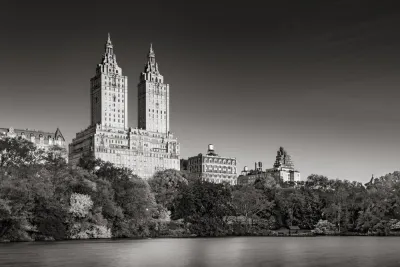In a free market, the richest neighborhoods would ordinarily be the most popular. But some well-off urban neighborhoods are actually losing population. Why?

When I reviewed New York City population data for a recent blog post, I discovered something surprising: two of Manhattan’s wealthiest areas, the Upper East Side and the Upper West Side, have lost [pdf] population since 2000.
Why doesn't this make sense? In a free market, affluent areas would normally be the most desirable, and as a result would attract new development and thus gain population. But the Upper East and West Sides have attracted little new housing. In fact, the Upper East Side has fewer housing units than it did in 2005; the Upper West Side's housing inventory has increased during this period, but by only 3 percent (from just over 115,000 units to just over 119,000)—a fairly astounding figure given the intensity of demand for Manhattan's more affluent neighborhoods.
This pattern is not unique to New York City. For example, Chicago's Lincoln Park, one of the city’s more affluent old neighborhoods, lost housing units during the 2000s. In the richest zip code in San Francisco's Pacific Heights (94123), the number of housing units increased between 2000 and 2016, but by less than 3 percent (from 14,851 to 15,217). In Washington's 20008 zip code (which includes most of the well-off areas surrounding upper Connecticut Avenue), the number of housing units increased by less than 1 percent (from 16,890 to 16,994).
Why would the richest areas lose population when other intown neighborhoods are becoming more populous? One likely culprit is zoning: the richest areas are the most politically powerful, and thus the most likely to resist new development. In New York, upper-class white areas are the most likely to be downzoned [pdf], while lower-class areas tend to be upzoned.
It could be argued that the real culprit for upper-class underpopulation is high vacancy rates caused by rich people using Manhattan apartments as second homes or investment vehicles. There is a tiny grain of truth to this argument: it is true that the Upper East Side and Upper West Side have more unoccupied homes than the rest of New York City. But in the four Upper East Side codes for which I was available to find data (10021, 10028, 10049, 10128), the number of unoccupied residences used for seasonal/occasional use (as opposed to being for sale or rent) actually decreased between 2000 and 2010. Moreover, that theory does'’t explain the loss of housing units in other cities: in Lincoln Park and the other non-New York zip codes discussed above, the unoccupied unit rate is about 8-9 percent, comparable to or even below citywide averages.
What happens when the richest areas don't allow new housing? First of all, housing prices go up a little everywhere as citywide supply is reduced. Second, people priced out of those areas move to cheaper areas and gentrify them—so people worried about gentrification and displacement should be especially worried about restrictive zoning in upper-class areas. Or to put it another way: if you don't want the upper class invading working-class areas, build more housing in the upper-class areas.*
*I note, however, that my point cuts both ways: it could be argued that by freezing people out of high-end areas, zoning prevents urban decline by encouraging gentrification of poorer areas. Whether you find the latter argument persuasive depends on whether you worry more about rising rents or about neighborhood decay; the best answer may be different in different cities.

Analysis: Cybertruck Fatality Rate Far Exceeds That of Ford Pinto
The Tesla Cybertruck was recalled seven times last year.

National Parks Layoffs Will Cause Communities to Lose Billions
Thousands of essential park workers were laid off this week, just before the busy spring break season.

Retro-silient?: America’s First “Eco-burb,” The Woodlands Turns 50
A master-planned community north of Houston offers lessons on green infrastructure and resilient design, but falls short of its founder’s lofty affordability and walkability goals.

Test News Post 1
This is a summary

Analysis: Cybertruck Fatality Rate Far Exceeds That of Ford Pinto
The Tesla Cybertruck was recalled seven times last year.

Test News Headline 46
Test for the image on the front page.
Urban Design for Planners 1: Software Tools
This six-course series explores essential urban design concepts using open source software and equips planners with the tools they need to participate fully in the urban design process.
Planning for Universal Design
Learn the tools for implementing Universal Design in planning regulations.
EMC Planning Group, Inc.
Planetizen
Planetizen
Mpact (formerly Rail~Volution)
Great Falls Development Authority, Inc.
HUDs Office of Policy Development and Research
NYU Wagner Graduate School of Public Service




























